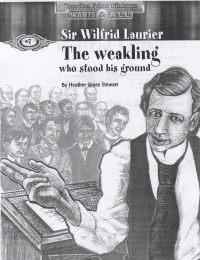| ________________
CM . . .
. Volume XII Number 16 . . . .April 14, 2006
excerpt:
Part of the planned 22-volume “Warts & All” series about Canadian Prime Ministers, this book features Canada’s first French-speaking leader and seventh Prime Minister, Wilfrid Laurier. Eight chapters chronicle Laurier’s life, from his birth in Quebec in 1841 and his humble beginnings, to his knighthood, a longtime career in politics and his lasting contributions to Canada. A lawyer by profession, Laurier was convinced by friends to run as a Liberal Member of Parliament, and, in 1874, he won his first seat. Plagued by chronic bronchitis, he was considered by some to be weak and fragile, yet when he delivered an impassioned speech, his fragility seemed to melt away. Laurier was a brilliant public orator and debater, eloquent, charismatic and empathetic. In 1897, he and his wife, Zoé, were invited to England to celebrate Queen Victoria’s diamond jubilee. While there, not only was he knighted by the queen, but he also received honorary degrees from Oxford and Cambridge Universities. Throughout his political career, he demonstrated fairness, tolerance and conviction to stand up for what he truly believed. One example of this was his siding with Louis Riel on the position of Métis rights. He argued against dual representation to avoid conflicts of interest between the provincial and federal governments, set up Canada’s first Department of Labour in 1900 and the Federal Civil Service Commission, in 1907, to ensure that government employees were qualified for their jobs. Among his many other contributions were the creation of Alberta and Saskatchewan, the establishment of the Yukon as a territory and the promotion of the Committee of Natural Resources for the protection of the environment. He also attracted immigrants to settle the west, created a new transcontinental railway and began to build the Canadian navy. In 1909, when party members opposed his motion to create a Department of External Affairs to monitor treaties and settle disputes, Laurier wrote a letter of resignation. However, his party soon realized their mistake, and Laurier continued as leader. However, he lost the election of 1911 to Sir Robert Borden’s Conservatives over his position on free trade, the unfinished railway and what was dubbed his “tin pot navy.” As Opposition leader, he spoke up about French language rights and against conscription. Laurier died in 1919. Stewart’s writing style is in keeping with the other volumes in this series. It is fluent, unbiased and engaging. Words printed in boldface type appear in an extensive glossary. There is also a table of contents, a time line of important dates and events which occurred during Laurier’s lifetime, an index and a list of suggested books, web sites and places to visit in Canada for further study. Also included are several pages of “Hot Topics,” a few examples being immigration’s impact on Canada and how Laurier’s relationship with a friend’s wife was the subject of rumour and scandal, though nothing was ever proven. Illustrations consist primarily of drawings and paintings although there are a few photographs as well. A cartoon beaver character appears in each of the volumes in the series, providing additional facts while coloured bands in each chapter serve as time lines of the events covered. The main strength of the books in the series is their ability to showcase not only the Prime Ministers’ wonderful contributions to this country, but also their weaknesses as leaders and human beings, making them more “human” and appealing to the reader. This title would be a welcome addition to any school or public library. Highly Recommended. Gail Hamilton is a teacher-librarian in Winnipeg, MB.
To comment
on this title or this review, send mail to cm@umanitoba.ca.
Copyright © the Manitoba Library Association. Reproduction for personal
use is permitted only if this copyright notice is maintained. Any
other reproduction is prohibited without permission.
NEXT REVIEW |
TABLE OF CONTENTS FOR THIS ISSUE
- April 14, 2006.
AUTHORS |
TITLES |
MEDIA REVIEWS |
PROFILES |
BACK ISSUES |
SEARCH |
CMARCHIVE |
HOME |
